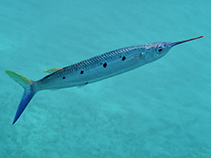| Family: |
Hemiramphidae (Halfbeaks) |
| Max. size: |
45 cm TL (male/unsexed); max. reported age: 4 years |
| Environment: |
reef-associated; brackish; marine; depth range 0 - 6 m, non-migratory |
| Distribution: |
Indo-West Pacific: Red Sea and East Africa to Samoa, north to the Ryukyu Islands, south to northern Australia and New Caledonia. Migrated to the eastern part of the Mediterranean Sea via the Suez Canal. |
| Diagnosis: |
Dorsal spines (total): 0-0; Dorsal soft rays (total): 12-15; Anal spines: 0-0; Anal soft rays: 10-12. Greatly prolonged, beak-like lower jaw; upper jaw short, triangular and without scales; preorbital ridge absent; total number of gill rakers on first gill arch 25-36; pectoral fins short, not reaching past nasal pit when folded forward; with 3-9 (usually 4-6) vertical bars on the sides. (Ref. 9843). Color bluish dorsally, silvery on sides. 36-41 predorsal scales. Lower lobe of caudal fin longer than upper lobe. Dorsal and anal fins located posteriorly.
Description: Characterized by dorsal fin yellowish; blue lower lobe and yellowish upper lobe caudal fin; tip of lower jaw, red; depth of body 5.7-7.3 in SL; well developed anterior lobe of dorsal fin; width of body contained 1.3-1.8 in its depth; lower lobe of caudal fin longer than upper (Ref. 90102). |
| Biology: |
Occur in coastal waters of high islands and continental shorelines; generally in areas rich in vegetation (Ref. 5213) and sand flats (Ref. 48635). Form schools. Adults feed mainly on seagrasses, to a lesser extent on green algae and diatoms (Ref. 9843). Breed in estuaries (Ref. 4164). Marketed fresh and dried salted (Ref. 5284, 9843); meat tasty (Ref. 637). Also caught with dragnets (Ref. 30573) and dipnets. |
| IUCN Red List Status: |
Not Evaluated (N.E.) Ref. (130435)
|
| Threat to humans: |
harmless |
Source and more info: www.fishbase.org. For personal, classroom, and other internal use only. Not for publication.
